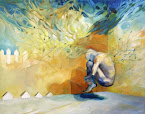This film showed a very cooperative and satisfying compromise of Hollywood continuity editing and the newer style, more disjunctive editing.
The scenes never jumped around to the point where the audience would be confused. It just jumped around in logical places. Sometimes it was a tad confusing, but never frustratingly so. It was part of what made that movie fun and not boring.
The rhythm of the editing in the movie was closely linked to the story's rapid progression and urgency. Things happened quickly between Bonnie and Clyde and things happened quickly to and for Bonnie and Clyde. The editing indicated this, especially in the final sequence when they were shot to death. Everything was very quick, yet their movements (which were in slow motion) sort of mirrored the audience's disbelief.
Emotional and intellectual responses evoked by the editing choices were complex. The audience is made aware of Clyde's interest in Bonnie, Bonnie's attraction to Clyde, C.W.'s amusement by the two, and so on.
Continuity editing was used whenever cars pulled up around a building or during the car chases. The practice encouraged the audience to identify with the characters or believe in the story's world because it makes everything reliable. The geography was faithfully established in every scene and the movie had a very linear time line. That said, whenever there was a sudden jump, one could always rest assured that it was at least a jump forward and not a jump backward.
Since both continuity and disjunctive editing were present in Bonnie and Clyde, they interacted with one another and that interaction was skillfully executed.
Tuesday, October 27, 2009
Subscribe to:
Post Comments (Atom)

Who edited this final scene? I know that Dede Allen is the overall editor of this film production, however i also know that she didn't edit this final scene. Do you know the name of the editor of this part of the film?
ReplyDelete